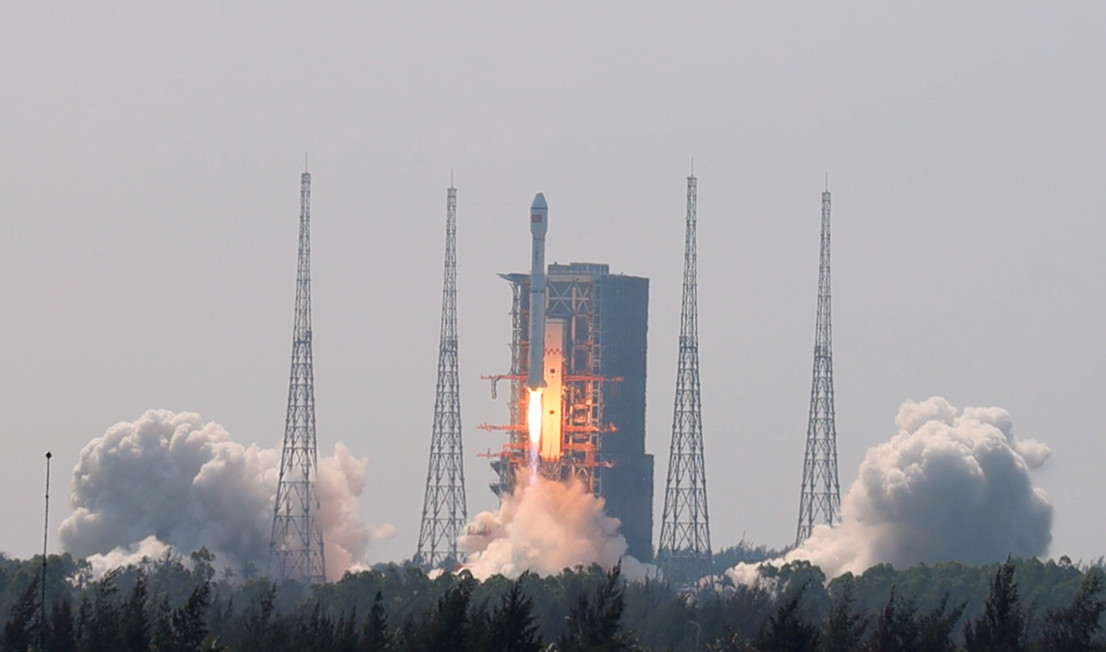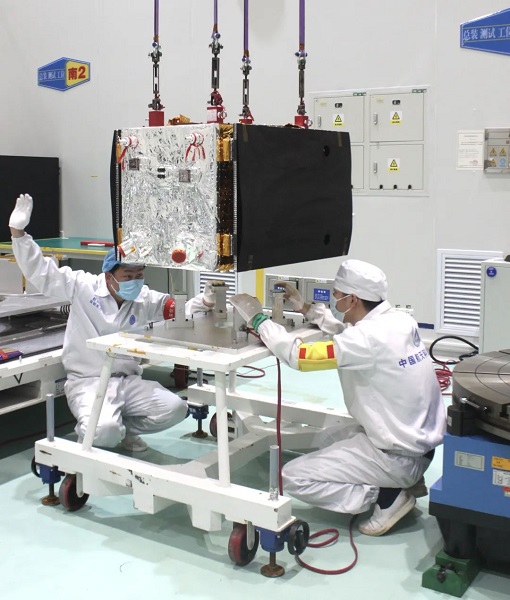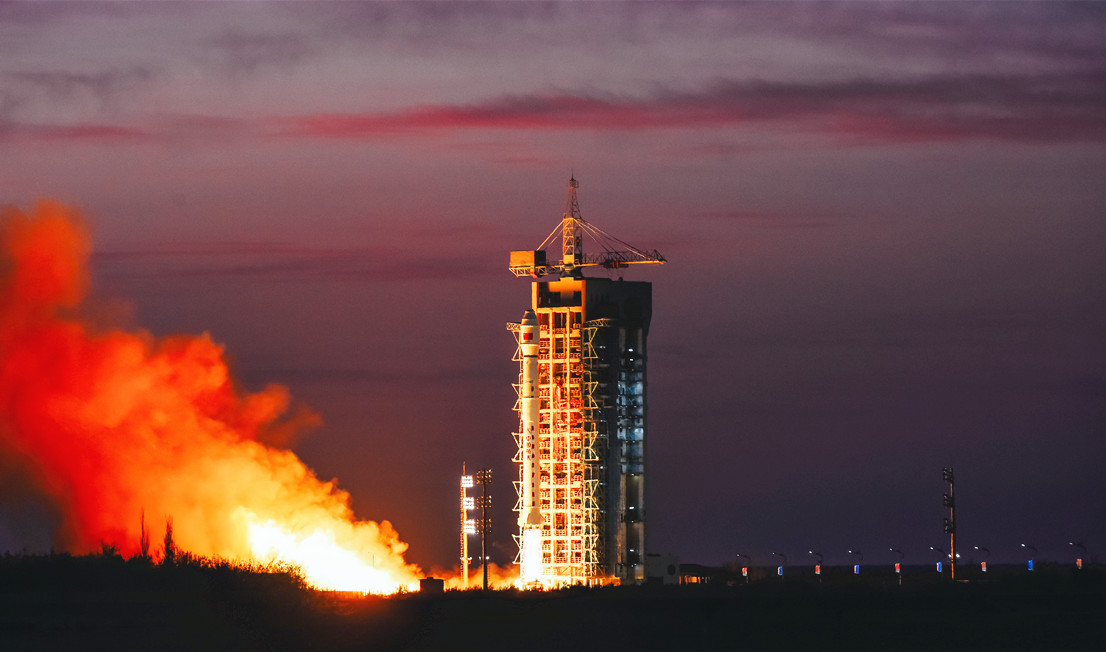
Two recent launches from China set a new record for the largest number of satellites ever deployed by a Chinese rocket, and added a new radar imaging capability to the country’s remote sensing fleet.
The launch of a Long March 8 rocket on Feb. 27 delivered 22 small satellites into orbit, hauling payloads to space for Earth-observing, maritime surveillance, communications, and technology demonstration missions.
The Long March 8 rocket launched at 0306 GMT on Feb. 27 (10:06 p.m. EST on Feb. 26) from the Wenchang space center, China’s newest spaceport built on Hainan Island. The 157-foot-tall (48-meter) rocket flew south from Wenchang to head for a polar orbit at an altitude of more than 330 miles (530 kilometers).
The mission was the second flight of a Long March 8 rocket, part of a new generation of Chinese satellite launchers that burn non-toxic kerosene and hydrogen fuels, replacing the noxious mix of hydrazine and nitrogen tetroxide propellants used on the older Long March 2, Long March 3, and Long March 4 rocket families.
The first Long March 8 flight in December 2020 used a version of the rocket with two liquid-fueled side-mounted boosters. The launch Feb. 27 employed a less powerful variant of the Long March 8 without the boosters.
With the two boosters, a Long March 8 rocket can carry a payload of about 9,900 pounds (4.5 metric tons) to a 435-mile-high (700-kilometer) polar sun-synchronous orbit. The new variant, without boosters, is capable of hauling a payload of up to 6,600 pounds (3 metric tons) to a low orbit, according to China’s state-run Xinhua news agency.
Two kerosene-fueled YF-100 engines power the Long March 8’s first stage, and two hydrogen-fueled YF-75 engines drive the second stage.
Among China’s new generation of launchers, the Long March 8’s lift capability places its performance between the lighter Long March 6, and the heavier Long March 7. The Long March 5 is China’s heaviest rocket, designed to place large modules into orbit for the Chinese space station.
The Long March 8 that flew Feb. 27 also used a shortened payload fairing. The 22 satellites packed inside the payload shroud, along with their mounting structures, weighed about 5,700 pounds (2.6 metric tons), according to the China Aerospace Science and Technology Corp., China’s largest state-owned aerospace contractor.
The 22 Chinese satellites deployed from the Long March 8’s second stage at 12 predetermined times, ensuring the spacecraft would not collide with one another after reaching orbit.
The satellites included 10 Jilin 1-series optical remote sensing satellites built by Chang Guang Satellite Technology Co. Ltd., a commercial remote sensing company based in China’s Jilin province. The high-resolution Earth observation satellites are each about the size of a household oven.

There were two satellites on-board the Long March 8 rocket — Hainan 1-02 and Hainan 1-02 — designed for maritime surveillance. They were built by Shenzhen Aerospace Dongfanghong Satellite Co. Ltd.
The Wenchang 1-01 and Wenchang 1-02 microsatellites, developed by MinoSpace, will collect imagery for oceanography, agriculture, and natural resource monitoring. The Taijing 3-01 and Taijing 4-01 satellites, also built by MinoSpace, host optical and radar remote sensing payloads, respectively.
The mission also deployed the Chaohu 1 radar satellite for Spacety Co. Ltd., and the Tianqi 19 commercial data relay satellite for Guodian Gaoke, a Beijing-based company developing an internet of things constellation.
Other satellites on the Long March 8 rocket included Starera 17, also known as Dayun, another optical remote sensing satellite. Phospherus 1 from Wuhan University, and Xidian 1 from MinoSpace also launched on an optical Earth-imaging mission.
The Thor Smart Satellite, designed for scientific research, rounded out the payload list, according to China Great Wall Industry Corp., which arranged the Long March 8 commercial rideshare mission.

The launch of the Long March 8 from Wenchang occurred less than four hours after the liftoff of a Long March 4C rocket from the Jiuquan space center in the Gobi Desert of northwestern China.
The Long March 4C took off at 2344 GMT (6:44 p.m. EST) on Feb. 26, according to CASC. The payload was the Ludi Tance 01B radar satellite, also called L-SAR 01B, developed by the state-owned Shanghai Academy of Spaceflight Technology.
The Ludi Tance 01B satellite will fly in formation with Ludi Tance 01A, which launched on a Long March 4C rocket in January.
The satellites — each more than three metric tons in mass — are designed for land imaging, and can be used for geological monitoring, tracking earthquakes, landslides, and other changes in land surfaces, CASC said in a statement.
Email the author.
Follow Stephen Clark on Twitter: @StephenClark1.
